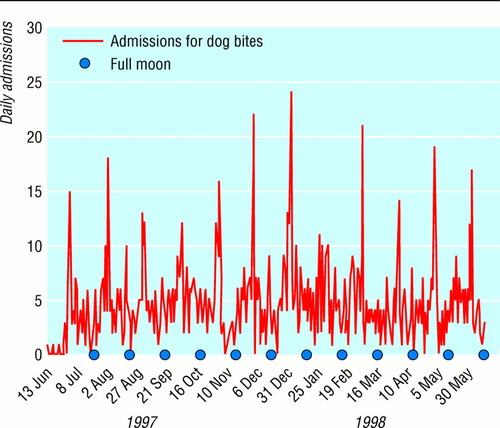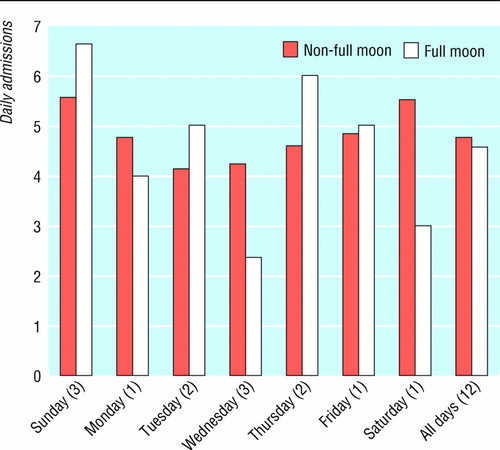In March 2000, Dr. Simon Chapman and colleagues from the University of Sydney published a paper in which they assessed the effectiveness of an educational intervention for the prevention of dog bites in children.
"Prevent-a-Bite" is an educational programme designed for primary school children. The programme aims to instill precautionary behaviour around dogs, assuming that this might reduce the incidence of attacks. A randomised controlled trial of the efficacy of the intervention was conducted in Australian children aged 7-8 years who were presented with an unsupervised opportunity to approach a strange dog.
Shortly after the publication of this paper, Chapman received a short note from a local farmer: "Have you university types ever looked at whether dog bites happen more around the full moon? It's a well known fact that they do."
It is also a well known fact that farmers (not to mention the rest of humankind) are the unwitting victims of confirmation bias, recall bias, and other various invisible gorillas. The nature of the human mind, combined with the rich oral folkloric traditions passed down from earlier generations of farmers to later generations, makes the persistence of these myths understandable. Being university types of the highest order and respectability, Chapman and a colleague, Stephen Morrell had no choice but to respond, so they "leashed their skepticism" and investigated.
They note: "Although more women have been documented to menstruate around the full moon," (really? I'm skeptical. paging Scicurious) "research has generally failed to confirm any association between the full moon and the manifestation of psychiatric disorders or violence in psychiatric settings, consultations for anxiety or depression in general practice, suicide and self poisoning, agitation among nursing home residents, car accidents, major trauma, or emergency department admissions."
But perhaps man's best friend is more susceptible to the tidal effects of the moon than is man himself. Chapman and Morrell decided that they had to determine if dogs bite humans more often when it is a full moon, or if Rover's bark is truly worse than his bite.
The researchers accessed twelve months' worth of public health records, and extracted the data on daily admissions for dog bites from all accident and emergency departments in Australian hospitals. They selected a year (June 13, 1997 through June 12, 1998) that had sufficient full moons and dog bites so that any significant correlation could be ...sniffed out (with thanks to the authors for the brilliant pun). The ended up with a total of 1671 dog bites, an average of 4.58 bites per day. Peak days were identified, which contained higher than ten admissions per day. Full moons coincided with exactly zero peak days. (Shocking, I say. SHOCKING.)

Average admission for each day was analyzed in comparison to the occurrence of a full moon, divided by day of the week. So the average number of dog bites that occurred on all full moon Fridays was compared with the average number of dog bites that occurred on all other Fridays, for example.

The most dog bites occurred on weekends (average 5.5 for Saturday, 5.6 for Sunday), which makes sense because more people are spending their time interacting with their pets on weekends.
Average number of bites on weekdays ranged from 4.1 to 4.9, forming an inverted U with the lowest number on Wednesday, and higher numbers approaching the weekends. There were more dog bites on full moon days for Sunday, Tuesday, and Thursday, and significantly fewer dog bites on full moon days for Monday, Wednesday, and Saturday. There was no significant difference for Friday. This haphazard, random association of full moons with dog bites would be expected if dog bites occurred, well, randomly with respect to full moons.
I, for one, am glad that we university types have things like statistics and empirical data on our side. Otherwise, we'd suffer the same confirmation bias as that lunatic farmer. And that would be bad times, indeed.
Chapman S, & Morrell S (2000). Barking mad? another lunatic hypothesis bites the dust. BMJ (Clinical research ed.), 321 (7276), 1561-3 PMID: 11124174
Dog image source.
- Log in to post comments




OK, so there is no significant correlation between full moon and dog bites, but what is causing the spikes on the graph?
The x axis is too small scale to see detail but it certainly looks like there is a regular(ish) spike in bites, over 10 bites per day, about once a month.
Ian: weekends. It's described right there, in the paragraphs under the figure. Did you stop reading before the end?
Some of the large spikes could be explained by social factors - ie. holidays during which many people visit their relatives and friends at their homes, times of the year during which people are likely to get new pet dogs, things like that.
There are four weekends a month, not one.
I am with Ian. No doubt in my mind that that the Fourier Transform of this data shows a strong (and statistically significant) peak at monthly frequency. The interesting question is its phase--which looks like it's spot on the new moon.
Mike (@3) has it spot on. There are more bites on weekends as well as during winter break - the days surrounding Christmas and New Years... As would be expected simply because people aren't at work and school, and are instead hanging out with their pets.
More interesting is why some people are convinced - by eye-balling a graph with insufficient resolution on the X-axis - that there MUST be some causal relationship between moon phase and dog bites.
The data should be broken down according to diurnal vs. nocturnal bite incidents. Perhaps dog bites at night would correlate better with moon phase.
Oi Jason!
_Summer_ holidays in December...
:-)
I also wondered like Darwinsdog (when I started reading the article) if there was any corelation would it have to do with dogs being out on moonlit nights, and did the not so crazy farmer mean dog bites on _stock_ (from which he wrongly extrapolated dog bites in general).
Other than very subtle tidal influences, it's hard to imagine what effect the full moon would have on dogs during the daylight hours. It might be different at night when moonlight or its lack could conceivably influence dog behavior. Since the data presented doesn't break down the time of day or night the bites occurred, correlation between moon phase & bite frequency at night might be masked.
Also, only bites on humans that required emergency room treatment are reported. Dog bites on other dogs, on livestock (as stephenk suggests), and on people who don't seek medical attention, aren't taken into consideration. We can't know from these data whether or not a correlation could be identified if all bites were reported.
I'd agree with stephenk. It'd be interesting to see whether dogs who are known to roam roam farther on moonlight nights, or whether diminished vision accompanied by good senses of hearing and smell allow them to navigate as easily to the sheep etc on overcast nights/when there are crescent moons.
Stephenik: Yes, Australia in December. People are going to be outside with their dogs more and encountering other people in the summertime.
John,
only having a gentle dig at north-o-centrism. :-)
also not sure where you are from but the nicest weather in the year to be out and about for me can be about now and about march-april. Dec-Feb can be a bit trying at times.
This wasn't pleasant to be in:
http://en.wikipedia.org/wiki/Early_2009_southeastern_Australia_heat_wave
simba: Actually full moons do not improve night vision, at least not in humans (maybe in dogs though) it makes it worse, harder to see in the shadows.
There certainly are 12 pretty evenly spaced dramatic peaks...does seem to correlate with the new moon. How did they explain the monthly spikes?
It's really interesting how this all started, technically, because of folklore. Is there a specific reason why that farmer, or countryfolk in general, believe that dog bites occur more on full moons, besides the folklore?
And are there any other situations where superstitions affect how people think, even when scientific evidence proves otherwise? For example, bad luck caused by black cats, or walking under ladders. I think it's just another area of the human psychology that deserves to be explored.
Isabel, et al, re 'sort of'? monthly spikes:
(monthly) meter readings (electricity, gas, other?).
Do the data include who got bit (age, sex, occupation)?